Assessment about Knowledge 2022
Added on 2022-09-21
134 Pages22256 Words65 Views
Assessment Workbook 1 Version No. 3.4 Produced 7 February 2018
Page 1 © Compliant Learning Resources
Page 1 © Compliant Learning Resources

KNOWLEDGE ASSESSMENT
Part A
1. You are required to demonstrate how to access the following in
relevance to ensuring the health and safety of children in the
workplace:
the National Quality Framework
the National Quality Standards
the relevant approved learning frameworkGuidance: Fill out each section in the table below using relevant
information from the National Quality Framework, The National
Quality Standards, and the relevant approved learning framework.
a. Under the NQS there are a number
of standards that are relevant to the
safety of children in an Early
Childhood Education and Care
service. What are the 2 main
Standards that support this?
i. The National quality standards is
an integral part of Early Years
Learning Framework (EYLF)
(White and Fleer 2019). These
standards are formulated under
National Law and Regulations of
Australia where an educational
program is approved under
certain circumstances, to be
qualified as an effective learning
framework. The NQS focusses on
fulfilling the developmental needs,
the interests and the experiences
in every individual child, based on
their personality(Christiansen
et
al. 2018)
ii. There are certain standards which
chiefly focusses on safety in
relevance to Early Childhood
education and Care service.
Quality area 2 – children’s health
and safety is a critical NQS
standards that pertains to safety
(Siraj
et al. 2019)
iii. The quality area 3 of NQS pertains
to fostering of a safe physical
environment in order to enhance
and promote child
Assessment Workbook 1 Version No. 3.7 Produced 17 September 2018
Page 2 © Compliant Learning Resources
Part A
1. You are required to demonstrate how to access the following in
relevance to ensuring the health and safety of children in the
workplace:
the National Quality Framework
the National Quality Standards
the relevant approved learning frameworkGuidance: Fill out each section in the table below using relevant
information from the National Quality Framework, The National
Quality Standards, and the relevant approved learning framework.
a. Under the NQS there are a number
of standards that are relevant to the
safety of children in an Early
Childhood Education and Care
service. What are the 2 main
Standards that support this?
i. The National quality standards is
an integral part of Early Years
Learning Framework (EYLF)
(White and Fleer 2019). These
standards are formulated under
National Law and Regulations of
Australia where an educational
program is approved under
certain circumstances, to be
qualified as an effective learning
framework. The NQS focusses on
fulfilling the developmental needs,
the interests and the experiences
in every individual child, based on
their personality(Christiansen
et
al. 2018)
ii. There are certain standards which
chiefly focusses on safety in
relevance to Early Childhood
education and Care service.
Quality area 2 – children’s health
and safety is a critical NQS
standards that pertains to safety
(Siraj
et al. 2019)
iii. The quality area 3 of NQS pertains
to fostering of a safe physical
environment in order to enhance
and promote child
Assessment Workbook 1 Version No. 3.7 Produced 17 September 2018
Page 2 © Compliant Learning Resources

learning(Stewart 2016)
b. How is the health and safety of
children related to the EYLF?
Guidance: Outline which of the five
Outcomes addressed in the EYLF
most relates to the health and
safety of children and explain why.
The five outcomes that relates most to
health and safety of children are as
follows:-
1. ‘Each child’s wellbeing and
comfort is provided for,
including appropriate
opportunities to meet each
child’s need for sleep, rest and
relaxation’ (Barblett and Kirk
2018) – this NQS quality area 2
outcome help to ensure health
safety for the children by
addressing the physiological
needs of the children (Sharp
2016).
2. ‘Effective illness and injury
management and hygiene
practices are promoted and
implemented’ – this NQS quality
area 2 pertains particularly to
injury management of the
children and promotes safety
(Pollock, Warren and Andersen
2017).
3. ‘Healthy eating and physical
activity are promoted and
appropriate for each child’ –
again in this outcome of NQS
quality area 2, the educators
focus on the health safety of
each children by providing them
with nutritious food.
4. ‘At all times, reasonable
precautions and adequate
supervision ensure children are
protected from harm and
hazard’ – this outcome is very
important enhance children
safety which is done under
regular supervision by the
educators.
b. How is the health and safety of
children related to the EYLF?
Guidance: Outline which of the five
Outcomes addressed in the EYLF
most relates to the health and
safety of children and explain why.
The five outcomes that relates most to
health and safety of children are as
follows:-
1. ‘Each child’s wellbeing and
comfort is provided for,
including appropriate
opportunities to meet each
child’s need for sleep, rest and
relaxation’ (Barblett and Kirk
2018) – this NQS quality area 2
outcome help to ensure health
safety for the children by
addressing the physiological
needs of the children (Sharp
2016).
2. ‘Effective illness and injury
management and hygiene
practices are promoted and
implemented’ – this NQS quality
area 2 pertains particularly to
injury management of the
children and promotes safety
(Pollock, Warren and Andersen
2017).
3. ‘Healthy eating and physical
activity are promoted and
appropriate for each child’ –
again in this outcome of NQS
quality area 2, the educators
focus on the health safety of
each children by providing them
with nutritious food.
4. ‘At all times, reasonable
precautions and adequate
supervision ensure children are
protected from harm and
hazard’ – this outcome is very
important enhance children
safety which is done under
regular supervision by the
educators.
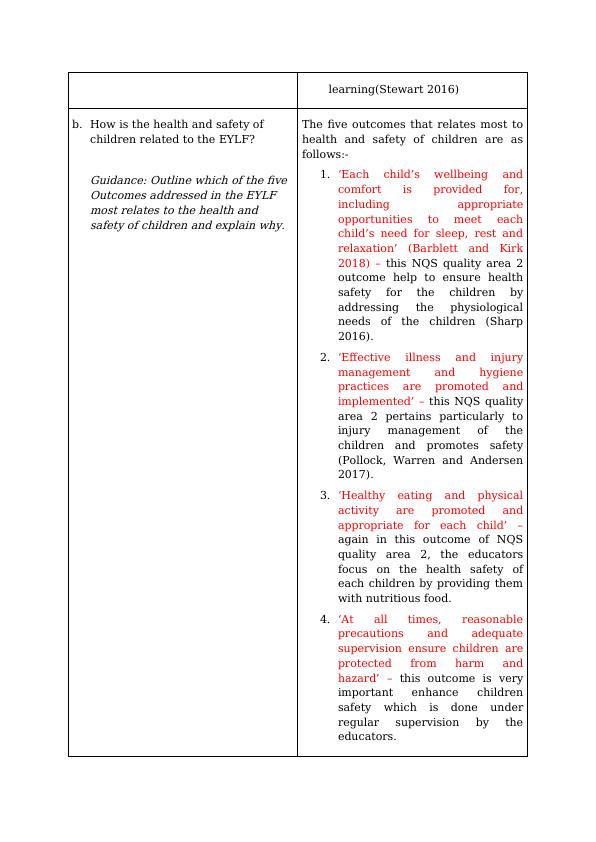
5. ‘Plans to effectively manage
incidents and emergencies are
developed in consultation with
relevant authorities, practised
and implemented’ – this outcome
is critically imperative to
children safety protocols as it is
focussed on acute and
emergency situations that might
arise in a given scenario.
c. What practice does the Guide to the
EYLF recommend that educators
use to raise and debate issues
relating to curriculum quality,
equity and children’s wellbeing?
‘Being, belonging and becoming’ is the
chief practice that is followed by the
EYLF educators to debate and raise
the issues related to children’s
wellbeing, equity and quality of
curriculum.
d. Review the practice section
outlined in the Framework for
School Age Care in Australia
(FSAC).
This section outlines that “nutrition
and safety” are seen as important
for educators to consider in relation
to _community_. (fill in the gap)
Which practice does this fall under?
The nutrition and safety section of
Framework for School Age Care in
Australia (FSAC) falls under reflective
‘cultural competence’ practice.
Assessment Workbook 1 Version No. 3.7 Produced 17 September 2018
Page 4 © Compliant Learning Resources
incidents and emergencies are
developed in consultation with
relevant authorities, practised
and implemented’ – this outcome
is critically imperative to
children safety protocols as it is
focussed on acute and
emergency situations that might
arise in a given scenario.
c. What practice does the Guide to the
EYLF recommend that educators
use to raise and debate issues
relating to curriculum quality,
equity and children’s wellbeing?
‘Being, belonging and becoming’ is the
chief practice that is followed by the
EYLF educators to debate and raise
the issues related to children’s
wellbeing, equity and quality of
curriculum.
d. Review the practice section
outlined in the Framework for
School Age Care in Australia
(FSAC).
This section outlines that “nutrition
and safety” are seen as important
for educators to consider in relation
to _community_. (fill in the gap)
Which practice does this fall under?
The nutrition and safety section of
Framework for School Age Care in
Australia (FSAC) falls under reflective
‘cultural competence’ practice.
Assessment Workbook 1 Version No. 3.7 Produced 17 September 2018
Page 4 © Compliant Learning Resources
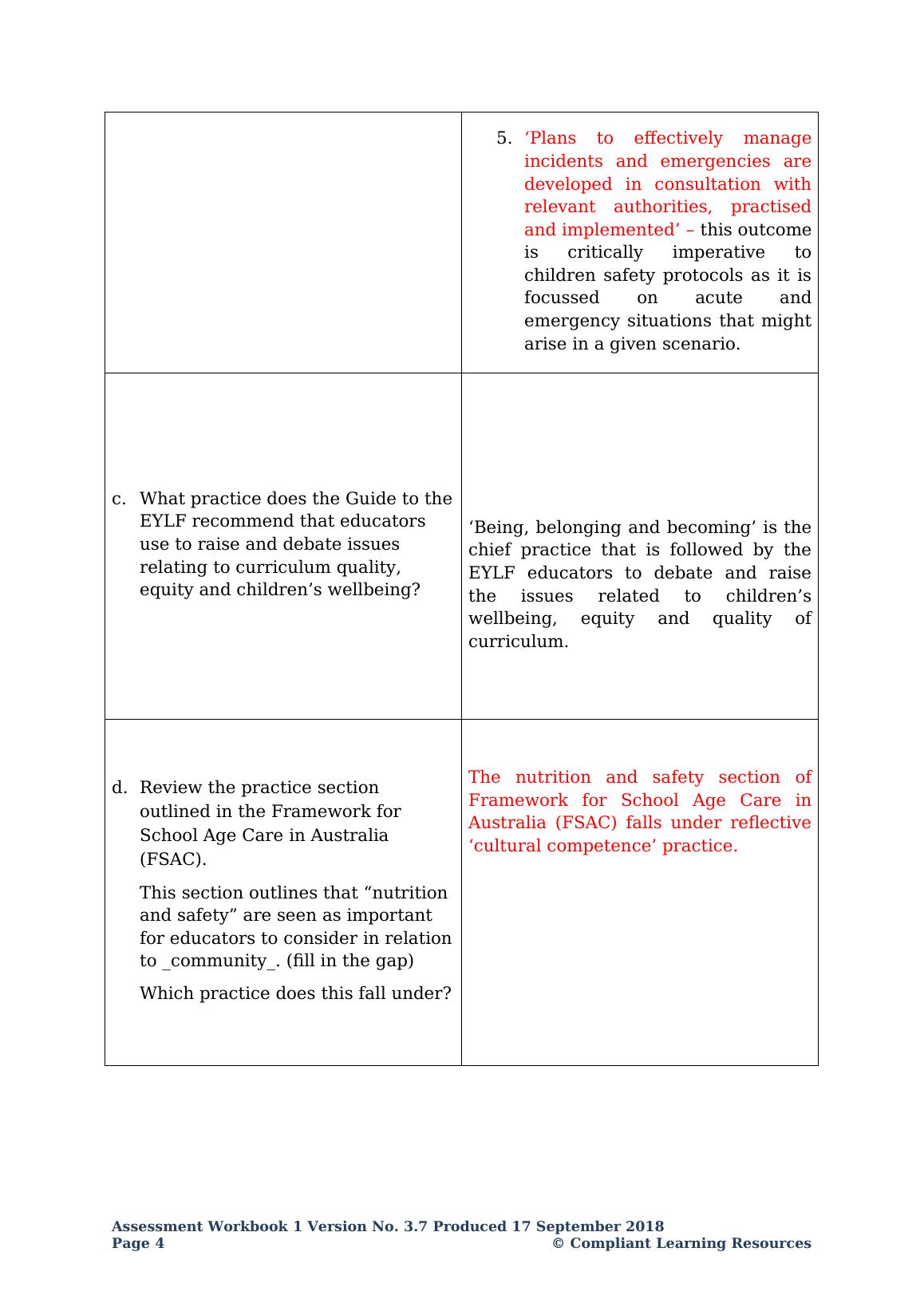
e. In the FSAC, it states that
educators can facilitate “Children
take increasing responsibility for
their own health and physical
wellbeing” by engaging children in
what activities that relate to safety?
In FSAC, the educators facilitate
‘Children’ take increasing
responsibility for their own health and
physical wellbeing’ by engaging the
children into active experiences, risk
taking, risk avoidance and transitions.
These can be play activities and socio
dynamic role playing.
f. Which two National Regulations
does the following statement relate
to?“minimise risks to children, an
education and care service or a
family day care educator must
implement:
• adequate health and hygiene
practices
• safe practices for handling,
preparing and storing food.”
Guidance: Refer to the National
Quality Framework website.
The two national regulations the
statements relate to are:-
1. Education and Care Services
National Regulations 2011 - 77
Health, hygiene and safe food
practices
2. 79 Service providing food and
beverages
g. Which National Regulation does the
below statement relate to?
“While attending an approved
service, children must have access
to safe drinking water at all times,
and have food and drinks available
throughout the day”Guidance: Refer to the National
quality framework website.
The national regulation that the
standard relate to – is
Education and Care Services National
Regulations 2011:
78 Food and beverages
educators can facilitate “Children
take increasing responsibility for
their own health and physical
wellbeing” by engaging children in
what activities that relate to safety?
In FSAC, the educators facilitate
‘Children’ take increasing
responsibility for their own health and
physical wellbeing’ by engaging the
children into active experiences, risk
taking, risk avoidance and transitions.
These can be play activities and socio
dynamic role playing.
f. Which two National Regulations
does the following statement relate
to?“minimise risks to children, an
education and care service or a
family day care educator must
implement:
• adequate health and hygiene
practices
• safe practices for handling,
preparing and storing food.”
Guidance: Refer to the National
Quality Framework website.
The two national regulations the
statements relate to are:-
1. Education and Care Services
National Regulations 2011 - 77
Health, hygiene and safe food
practices
2. 79 Service providing food and
beverages
g. Which National Regulation does the
below statement relate to?
“While attending an approved
service, children must have access
to safe drinking water at all times,
and have food and drinks available
throughout the day”Guidance: Refer to the National
quality framework website.
The national regulation that the
standard relate to – is
Education and Care Services National
Regulations 2011:
78 Food and beverages

2. In your role as an Early Childhood Education and Care worker, you
will need to check toys and equipment for potential risk and hazards
that may cause harm to children.
a) Explain in detail the steps involved in conducting a risk
analysis on toys and what you would be checking for at
each step.
b) Explain what steps you would take if you identified a toy or
piece of equipment that presented a WHS hazard with an
extreme risk.
c) Which policy, procedure would you refer to for advice on WHS
issues?Guidance: Include reporting procedures and the designated person
that you would report to according to organisational procedures.
Refer to the Hierarchy of Control.
Assessment Workbook 1 Version No. 3.7 Produced 17 September 2018
Page 6 © Compliant Learning Resources
will need to check toys and equipment for potential risk and hazards
that may cause harm to children.
a) Explain in detail the steps involved in conducting a risk
analysis on toys and what you would be checking for at
each step.
b) Explain what steps you would take if you identified a toy or
piece of equipment that presented a WHS hazard with an
extreme risk.
c) Which policy, procedure would you refer to for advice on WHS
issues?Guidance: Include reporting procedures and the designated person
that you would report to according to organisational procedures.
Refer to the Hierarchy of Control.
Assessment Workbook 1 Version No. 3.7 Produced 17 September 2018
Page 6 © Compliant Learning Resources
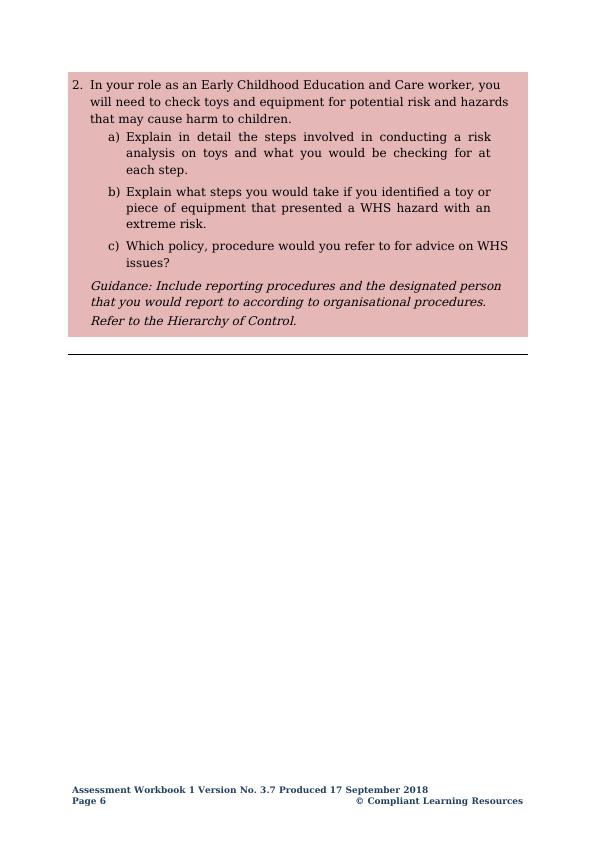
a. Steps involved in conducting a risk analysis on toys
The steps involved in conducting a risk analysis of toys are :-
1. Using the workplace procedures to identify any existing or potential
hazards
2. Reporting any kind of identified hazards, to the designated persons.
3. Record hazards according to workplace procedures, for example in a
checklist or hazard report.
4. Provide the report to the assessor.
The steps involved in conducting a risk analysis of toys are :-
1. Using the workplace procedures to identify any existing or potential
hazards
2. Reporting any kind of identified hazards, to the designated persons.
3. Record hazards according to workplace procedures, for example in a
checklist or hazard report.
4. Provide the report to the assessor.
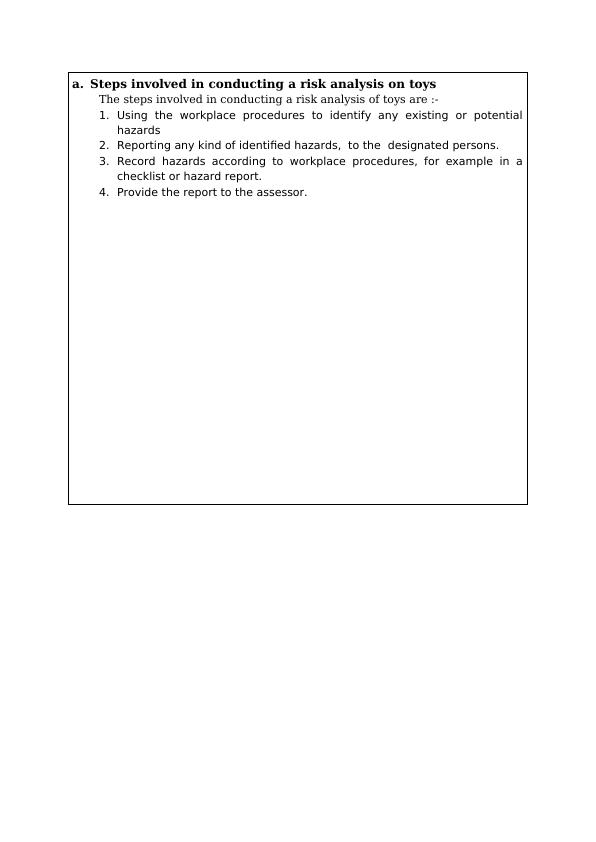
b. Steps you would take if you identified a toy or piece of
equipment that presented a WHS hazard with an extreme risk
The steps involved in WHS hazard management are as follows :-
Step 1 - Identify hazards – identifying the risks ( potential and ongoing) is
the first major step to management of a WHS hazard.
Step 2 - Assess risks – Assessing the level of risks posed is critical and next
in the chain.
Step 3 - Control risks – this is followed by active methods in controlling of
the risks identified.
Step 4 - Review control measures – lastly, it is very vital to review the
scenario in which the toy or equipment has been risked and the effectivity
of the control measures has to reviewed and recorded as well.
c. Policies and/or procedures to reference for WHS issues
The policies or procedures related to Work health and safety issues
ensures :-
1. Management must fulfils the responsibility to deliver a safety in
workplace, without any kind of negative impact on about health
employees;
2. The employees should meet the accurate health and safety obligations
that provides safety in a workplace (Bluff 2019).
3. The children, the families and all the visitors must come to workplace
that protects their wellbeing and health status(Potter et al. 2019).
4. The work environment must supports the quality framework of early life
education and child care (Potter et al. 2017).
The policies and procedures that pertains to WHS issues are :-
Emergency planning
Critical incident management
Emergency equipment ü First aid
Accident and incident reporting
Workplace inspections
Hazard identification & control (Risk Assessment & Hazard Register)
Chemicals & hazardous substances
Assessment Workbook 1 Version No. 3.7 Produced 17 September 2018
Page 8 © Compliant Learning Resources
equipment that presented a WHS hazard with an extreme risk
The steps involved in WHS hazard management are as follows :-
Step 1 - Identify hazards – identifying the risks ( potential and ongoing) is
the first major step to management of a WHS hazard.
Step 2 - Assess risks – Assessing the level of risks posed is critical and next
in the chain.
Step 3 - Control risks – this is followed by active methods in controlling of
the risks identified.
Step 4 - Review control measures – lastly, it is very vital to review the
scenario in which the toy or equipment has been risked and the effectivity
of the control measures has to reviewed and recorded as well.
c. Policies and/or procedures to reference for WHS issues
The policies or procedures related to Work health and safety issues
ensures :-
1. Management must fulfils the responsibility to deliver a safety in
workplace, without any kind of negative impact on about health
employees;
2. The employees should meet the accurate health and safety obligations
that provides safety in a workplace (Bluff 2019).
3. The children, the families and all the visitors must come to workplace
that protects their wellbeing and health status(Potter et al. 2019).
4. The work environment must supports the quality framework of early life
education and child care (Potter et al. 2017).
The policies and procedures that pertains to WHS issues are :-
Emergency planning
Critical incident management
Emergency equipment ü First aid
Accident and incident reporting
Workplace inspections
Hazard identification & control (Risk Assessment & Hazard Register)
Chemicals & hazardous substances
Assessment Workbook 1 Version No. 3.7 Produced 17 September 2018
Page 8 © Compliant Learning Resources
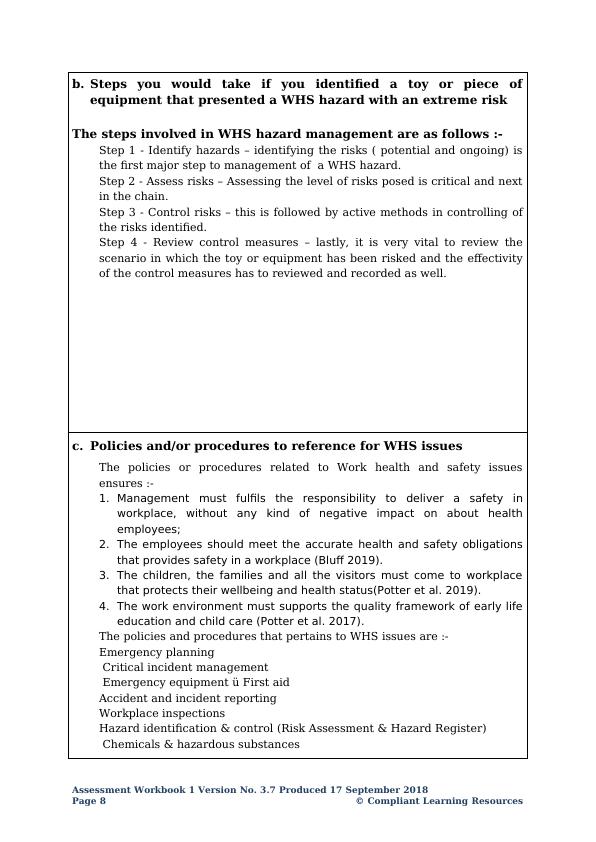
End of preview
Want to access all the pages? Upload your documents or become a member.
Related Documents
Ensuring Health and Safety of Children in Early Childhood Education and Care Serviceslg...
|42
|6271
|463
Using Learning Frameworks for Quality Education and Care - Deskliblg...
|7
|1344
|283
Early Years Learning Frameworklg...
|4
|909
|14
CHCECE009 Task 2 and 3 - Early Year Learning Framework and Educator Roleslg...
|15
|4137
|322
Importance of Practicing High Standards of Food Safety in Childcarelg...
|5
|1009
|368
Importance of Ensuring Health and Safety of Children in Early Education and Care Serviceslg...
|12
|3028
|3
